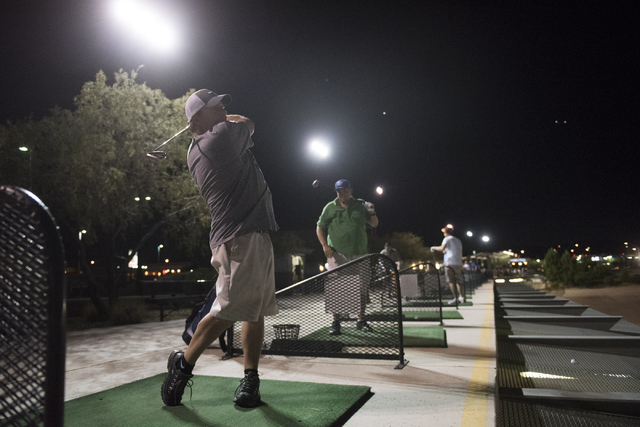In summertime heat, strange things start to happen in Las Vegas

When he first arrived in Las Vegas decades ago, Dr. Dale Carrison took mid-summer afternoon runs, oblivious to the danger of heatstroke.
From pockets of shade, construction workers shouted warnings between sips of water and Gatorade.
“They’d yell at me, ‘Hey a—hole!’ ” Carrison recalled. “ ‘Don’t you know you’re not supposed to be running?’ ”
It was a lesson Carrison, like most Las Vegas Valley residents, quickly internalized: Adapt to the Mojave heat or pay the price.
When the valley hits a stretch of heat like the past week or so — since June 11, the city has exceeded 100 degrees every day — strange things start to happen.
For one, emergency room doctors notice more third-degree burns associated with car crashes. The burns aren’t from fire, said Carrison, now medical director at University Medical Center, but from when well-meaning bystanders or passengers pull the injured from wreckage and lay them on hot asphalt.
“You know that whole thing about cooking eggs (on asphalt)?” Carrison said. “You can.”
Tourists and workers from out of town are susceptible to a phenomenon called “insensible fluid loss.” When coming from a place of higher humidity to the desert air, “you lose a lot more fluid just by breathing,” Carrison said. “So people don’t make up for that.”
The summer heat causes people to change their behavior, Carrison acknowledges.
After taking a look at Tuesday’s projected high of 108 degrees, golfers Tim Harrington, of Las Vegas, and Russell White, of North Carolina, went for a nocturnal option.
Later that night they whacked bright white golf balls off the second story of the TaylorMade Golf Experience driving range on Las Vegas Boulevard, across from Town Square.
“Can’t keep a golfer down, right?” White joked.
When the heat gets bad, Harrington said, he plays golf either at night (Angel Park Golf Club, on Rampart Boulevard at Summerlin Parkway, and TaylorMade have tee times until 9 p.m. and 10 p.m., respectively) or very early.
“It gets light at 5 a.m. The first tee time is at 6 a.m.,” Harrington said. “If they started earlier, I’d probably play then.”
The golfers’ strategy for extreme heat matches the medical advice of Carrison, who suggests residents limit their time outdoors to early mornings and late afternoons or evenings.
“What do Las Vegans do at night when it gets hot?” another night golfer, Zachary Grayson, asks rhetorically. “Hide.”
Historically, natives of the Las Vegas Valley have followed that advice.
For hundreds of years, the Paiute Native Americans picked up each summer and left the valley for the cooler climes of Mt. Charleston, according to Clark County Museum Director Mark Hall-Patton.
“I’m always trying to figure out how to move the Strip to Mount Charleston. Wouldn’t work very well,” Hall-Patton said.
Before the days of air conditioning, well-to-do Las Vegans bought cabins on Mount Charleston and moved their families there for the summer, Hall-Patton said. People also slept outdoors.
On especially hot days, Hall-Patton said, they would soak their sheets in water. When it evaporated it “would apparently allow you to sleep quite comfortably,” he said.
Mount Charleston continues to be popular. Traffic at the newly opened Spring Mountains Visitor Gateway has jumped from 80 people a day in early May to 200 people a day by mid-June, Jack Howell, visitors services information technician, said Wednesday. Eight hundred people visited the previous weekend, Howell said.
The temperature, as he spoke Wednesday, was 84 degrees on Mount Charleston.
Similar temperature drops are seen in outlying communities such as Indian Springs, Sandy Valley and Moapa, said Meggan Holzer, Clark County liaison to several unincorporated communities including Mount Charleston. When the sun leaves, some residents head for the hills.
“There’s a whole horse culture that rides in the evenings,” Holzer said. “People saddle up when the sun goes down and ride in dusk. Full moon rides are awesome.”
In 1911, when Vegas was a sleepy railroad stop between Los Angeles and Salt Lake City, the city’s first outdoor movie theater opened. Called the “Airdome,” it was opened to show movies in the summer by the owners of the Las Vegas Majestic Theatre, which did not have air conditioning. Located at Fremont and Third Street, it consisted of a bunch of chairs, a screen and a tall, circular wall so that people who hadn’t paid couldn’t see the shows, Patton said.
Today, AC continues to make movies a popular summertime escape. There also are drive-in shows at the West Wind Las Vegas 6, outdoor movies at Spring Mountain Ranch State Park and Henderson Pavilion and “Dive-In” flicks every Monday poolside at The Cosmopolitan.
There are other activities as well. Water parks (Wet ‘n’ Wild Las Vegas and Cowabunga Bay), ice skating rinks (Las Vegas Ice Center and several others) and bowling (Station Casinos has several lanes open until 2 a.m.) all draw in thousands looking to cool off.
Contact Knowles Adkisson at kadkisson@reviewjournal.com or 702-224-5529. Find him on Twitter: @knowlesadkisson.